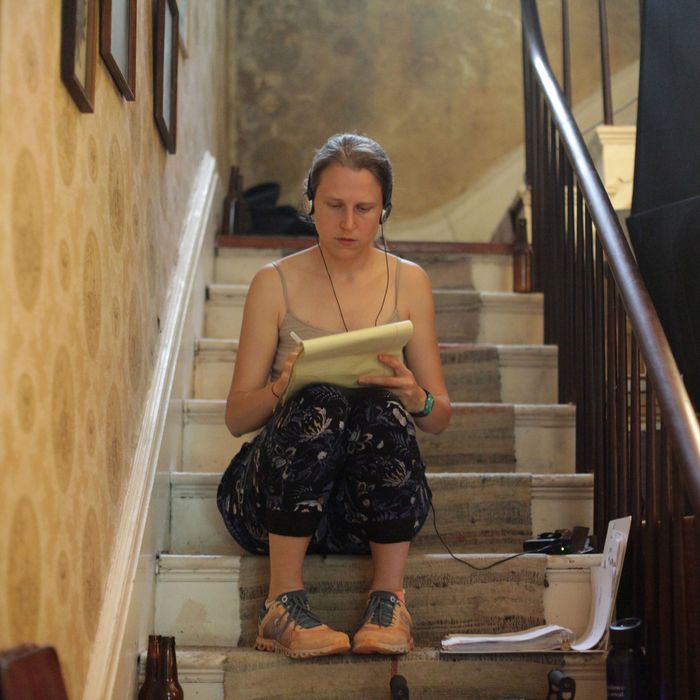
A decade ago, on a warm night in May, a young woman took off her dress in the atrium of the Museum of Modern Art. A murmur rose from the startled crowd. For an exhilarating moment, she stood there naked. In front of her, the renowned performance artist Marina Abramovic sat in a wooden chair, her head bowed, her white dress stretching all the way from her neck to the floor. Abramovic had been sitting in that chair for two and a half months. Thousands of visitors had taken turns sitting across from her, bathing in her gaze. But the young woman would never get a chance to take part in this singular ritual. As she began to sit, a phalanx of guards surrounded her, told her to put her dress back on, and led her away. Flustered and tearful, she tried to explain herself to a documentary crew outside the exhibition. “I would have obeyed the rule if I had known,” she said. “I just wanted to be as vulnerable with her as she makes herself to everyone else.”
The woman, Josephine Decker, was a 29-year-old SAT tutor and an aspiring filmmaker. Today, she is an actress, performance artist, and one of the most daring directors in the world of independent cinema. Her four feature films have brought her a devoted following of cinephiles, including The New Yorker’s Richard Brody, who has extolled her in terms that earlier generations of critics bestowed on the likes of Andrei Tarkovsky and Jean-Luc Godard. “Decker throws herself into the urgency, the infinite promise, and the danger of the cinema—and she seems to live, and to thrive, on the edge of that danger,” he wrote.
Her latest work, Shirley, stars Elisabeth Moss as the horror writer Shirley Jackson. Executive-produced by Martin Scorsese, who has credited Decker with helping to expand “the language of cinema,” it will likely find a wider audience than her earlier, more experimental films. Still, the movie has about as much in common with an average biopic as Tarkovsky’s Solaris has with Star Wars. Most of the action takes place at Jackson’s home in Bennington, Vermont, where Jackson’s husband, the professor and literary critic Stanley Edgar Hyman, has invited his teaching assistant, Fred, and Fred’s young wife, Rose, to move in with them and help around the house. An erotic energy flows between the two women, rousing Jackson from a state of creative paralysis while threatening to break apart both marriages. Although the drama unfolds in the mid-1960s, Decker’s style of filmmaking evokes the mumblecore movement of the early aughts, which she came out of. Cinematographer Sturla Brandth Grøvlen’s camera hovers over the characters’ faces like a housefly. Scenes crash into each other without warning or exposition.
Decker lives in Los Angeles with her partner and their 6-month-old daughter. In the weeks leading up to Shirley’s release, she spoke to me from her bedroom, which was strewn with musical instruments, volumes on sex and mythology, and a copy of the Bible. Decker is lithe and pale, and she wore her dirty-blonde hair in a ponytail. As she showed me around her disorderly space, she seemed to be grappling with the two opposing impulses that animate much of her work—a desire to fully expose herself to the viewer, and a deeply rooted fear of revealing too much. “My room is so embarrassing,” she said with a laugh, waving at a jumble of boxes, “but I guess I don’t get to say what you write about.” Shirley, like many of her earlier films, wrestles with questions of authorial control: Where does the boundary lie between the artist and the muse, and what happens when, inevitably, that line is crossed? In the film, when Rose falls under Jackson’s sway, she is destabilized while the writer is revived. Decker relates to Jackson, she told me, “in the way that you destroy yourself, and maybe destroy other people, to make your art.”
Decker wasn’t raised in a culture that encouraged the sort of openness she displays in her work. She grew up in Texas—Houston and then Dallas. Her father wrote poetry and introduced her to the films of Tarkovsky, but he was not a bohemian; he worked in private equity, and the family went to church every Sunday. The community’s silence around sexuality, especially female pleasure, weighed heavily on her. “I remember, when we were kids, asking my friends, ‘Are you guys masturbating?’ And they were like, ‘No, gross,’ ” she recalled. “I was very sexually repressed.”
In her early 20s, after graduating from Princeton, she co-directed a documentary about bisexuality. She was beginning to think of herself as bisexual, but the film was stiff and impersonal, and she now regards it as a failure. She found it difficult to shake the Christian concept of sin. “We were filming all this wildly sexual stuff and I was very guilty,” she told me. A moment later, she corrected herself: “Felt guilty.”
A turning point came when she discovered Abramovic’s work. “It undid me and all the ways I thought about myself,” she said. “I became wildly open. Maybe too open.” In the months after she undressed at MoMA, she acted in three films directed by Joe Swanberg, a mumblecore pioneer who helped launch the careers of Greta Gerwig and the Duplass brothers. Much of the work was explicitly sexual. “I was naked a lot that year,” Decker recalled. She and Swanberg were both interested in exploring the gray zone between their lives and their art, but these adventures could get messy. Swanberg made movies quickly and cheaply, casting his friends in roles that often mirrored their real lives. “It was a very confusing, nebulous cloud of emotion, sexuality, power,” Swanberg told me.
They made their first film, Uncle Kent, in the summer of 2010. It was “a very sexy experience,” she recalled. “I felt liberated and excited to be seen as a sexual being.” But Uncle Kent was “very PG 13.” Their next project, Art History, which they filmed later that summer, was not. “It was a very vulnerable time,” she said, her eyes drifting. It opens with Decker, who co-wrote the film with Swanberg and plays a version of herself, rubbing another actor’s penis. “When I think back on that time, there’s a part of me that …” She paused, searching for the right words. “Feels scared,” she continued. “Because I felt scared. Not always, not always. But it was hard to tell if I was respecting my own boundaries.” Swanberg, she said, was interested in the concept of “taking back the idea of pornography”—liberating sexually explicit work from the world of porn. “That wasn’t my pet cause,” she continued. “But I was the body.”
After the shoot, in July 2010, Decker sent Swanberg an email, enthusing over their work together while also saying she felt uncomfortable with that opening scene. “I’m still brewing over the beginning CU [close-up] of my hand putting the condom on and then rubbing Kent’s penis,” she wrote, referring to her co-star Kent Osborne. “I wanted to say something,” she continued in the email, “but I didn’t want to interrupt the creative flow with fears or worries and put up restrictions. I really wanted all of our energy to just flow. And I kept being like, ‘Just get over it, it’s not a big deal. It’s not a big deal.’ ” Decker focused on her aesthetic concerns: “That kind of image just says porn to me,” she wrote. She continued in this vein for a while, expressing her unease while reassuring Swanberg that she valued his artistic judgment. “I can definitely live with it,” she said, “but I really wanted to talk to you about it.”
Swanberg replied, “Yes, let’s talk about this.” Neither he nor Decker remember the conversation that followed, but the shot remained in the film, and for a few years, they continued to collaborate on various projects. Nearly a decade later, over dinner at the Maryland Film Festival, Decker finally told Swanberg what she’d fallen short of saying in her email all those years earlier: that the overall experience of filming the movie had made her feel afraid. When I spoke with Swanberg, he said, “it creates this weird asterisk on the movie. She’s my friend, and I hate that every time she thinks about it, she has this mostly positive feeling but partially bad feeling.” He said he wished she’d been more direct at the time. “A chaperone approach of repeatedly saying ‘Are you sure?’ feels antithetical to the relationship the two of us had,” he said. “She never said, ‘Joe, I hate this shot. I don’t want it in the movie.’ The question is: Could I have intuited that at the time?”
For her part, Decker isn’t sure. In the days since I’d begun interviewing her, she and Swanberg had been talking regularly, trying to sort out the past and imagine how things might have gone differently. The conversations had gotten her thinking about her upbringing. “As a person growing up in Texas, I was trained to never touch a man’s ego,” she began. “I’m really good at projecting a calm, collected exterior while inside I’m fully panicking. Certainly there was pressure from Joe to do this film in a certain way, and Joe is a very confident white man, which is the kind of person I have been taught to listen to and obey. But I can’t blame him, or I don’t know how much to blame him.” Contemplating her own role in what happened, she mused, “Did I give any clues of what was going on inside me? Was I the one exploiting myself? How much did I actively hide the emotions I was having?”
Decker still prizes their collaboration, perhaps in part because negotiating their limits has been so challenging. “I grew a lot from Joe and having to have difficult conversations with him,” she said. “That’s the beginning of intimacy — when you get to say, ‘I messed this up and I can’t take it back.’ That’s beautiful. That’s profound.” I asked whether she’d ever work with him again. She thought about it for a long time. Over the past few years, she said, she’d come up with an excuse each time he’d proposed they work together. But talking to him recently, something had shifted. “I’d make a piece with him about this,” she said. “This is the kind of messy shit I’m really interested in: the things that don’t get said, the boundaries that get a little bit crossed.”
In the fall of 2014, a few years after appearing in Swanberg’s films, Decker enrolled in a clowning workshop led by Quinn Bauriedel, the co-founder of the Pig Iron Theatre Company, an experimental theater ensemble in Philadelphia. Bauriedel had taught her as an undergrad at Princeton. In her college days, she was clearly brilliant but “buttoned-up,” he said. Now, a decade later, she seemed completely uninhibited. “She had a certain kind of freedom that was unstoppable,” he said. He recalled one performance in particular; it involved her speaking in tongues while wearing a clown nose. “The audience was in our chairs, frozen, having absolutely no idea what was about to happen,” he said. “A clown nose is a little mask, and at the end of the day you take it off. She was one of the people who had a hard time taking it off.”
By then, she had already premiered her first feature film, 2013’s Butter on the Latch. From Swanberg, she had learned how to make movies on a miniscule budget, but her style departed from mumblecore’s slouchy, naturalistic aesthetic. Both Butter and the film that followed, Thou Wast Mild and Lovely, were filled with surreal and jarring images: a young woman biting off a frog’s head before a kiss, a white-and-wild-haired woman dancing alone in the forest. Mild and Lovely is often described as an erotic thriller, but that label may misleadingly imply that the film employs such familiar genre devices as plot and suspense. Swanberg, who plays a leading role in the film, recalled laughing when she sent him the script. “I would use air quotes around ‘script,’” he said. “It was like a long poem. I read it and then I called her and said, ‘Josephine, I don’t know how to read this. Why don’t I just come to Kentucky and you tell me what to do.’”
In Decker’s third film, her breakthrough, Madeline’s Madeline, she reexamined some of the themes she’d begun thinking about on Swanberg’s shoots, this time through the lens of race. The movie tells the story of a young black actress in a fraught relationship with the well-meaning white director of her experimental theater troupe. The idea grew out of Decker’s own relationship with a teenage actress named Helena Howard, who captured her attention in 2014 while performing a monologue at a New Jersey arts festival where Decker was serving as a judge. After watching Howard inhabit the role of a girl who confronts her sexual abuser, Decker told her it was the greatest performance she had ever seen. They cried together and agreed to work together on a film.
Over the next three years, Decker led a group of actors and a bare-bones crew in a series of workshops. She encouraged the actors to improvise scenes based on their own lives. A self-reflexive story began to emerge, with Molly Parker playing the theater director, Evangeline, and Howard in the role of her lead actress and muse. The boundaries between life and art became “very murky,” Decker said. Throughout rehearsals, the cast and crew would talk through aspects of the process that made them uneasy. “You keep saying this is a collaboration,” she recalled one cast member pulling her aside and saying, “but you’re the director; you’re a white woman. There’s a power dynamic, and we can’t pretend we’re all creating together.” In the film’s climactic moment, the troupe of actors, rallying behind Howard, expel Evangeline from the set and take over the production. As Decker saw it, her fictional proxy, Evangeline, had “stolen something sacred from this young teenager she’s working with to make her art.”
But Howard said she never felt exploited on Decker’s set. “If there was anything I was uncomfortable with, I would tell her, and it would be gone,” she told me. “It’s about knowing when those boundaries are crossed, and I definitely didn’t feel like any of those boundaries were crossed.” Miranda July, who is a close friend of Decker’s and played the mother of Howard’s Madeline, said the director has a gift for listening to and talking through actors’ concerns. She recalled a moment, early in the filmmaking process, when she felt overwhelmed and tried to back out of the project. Decker accepted her decision, but as they talked it over, July realized her fears had abated. “ ‘Every time I talk to you,’ ” she remembers telling Decker, “ ‘I actually feel fine. And not scared.’ ” On the phone, as July related the story, she started crying. Working with Decker, she said, turned out to be “the opposite of the nightmare I had been having.”
Shirley Jackson and her husband, Stanley Edgar Hyman, were both obsessed with ritual and mythology. Hyman studied these ideas, and Jackson’s stories — blunt, haunting parables — embodied them. Much like Jackson’s modern fairytales, Decker’s films transport mundane experiences into the realm of the mythical, using the language of symbols and dreams. Shirley diverges from her earlier films in that she mostly worked from a screenplay written by someone else (Sarah Gubbins, who wrote on I Love Dick and Better Things), but some of its most interesting moments break away from the confines of narrative. At one point, the script called for the author’s muse, placed by Odessa Young, to plant a geranium in Jackson’s garden. In the middle of filming the scene, Decker pointed out to Young that her character was “disintegrating” and suggested she roll around in the mud. On a narrative level, the move made little sense, but it resonated with the deeper logic of Decker’s artistic universe. “Watching her work, I felt that she was someone who believes in magic, or in levels of reality that are not obvious,” July said.
When we next spoke, Decker led me in a ritual she’d learned at the Pig Iron Theatre Company. She was dressed like the priestess of some ancient cult in a long white dress with cutouts along the arms. She gathered a number of special objects from around her room — a woven percussion instrument from Brazil, some fennel seeds a friend had given her — and placed them around her. “You make four points around yourself and then you will be safe in this space that’s protecting you,” she explained. We lit candles and meditated, and she shared a practice she’d learned from Jean-Rene Toussaint, who voice-trains performance artists. “It’s all about finding your primitive voice,” she said. For the next five minutes, we stared at each other’s faces while making a variety of guttural noises. We cried out like newborns, groaned like people dying in agony. Later, reflecting on the experience, Decker said such practices had helped her overcome her inhibitions as an artist. “You shed one person and become another,” she said. “You lose your fear.”
*A version of this article appears in the June 8, 2020, issue of New York Magazine. Subscribe Now!



